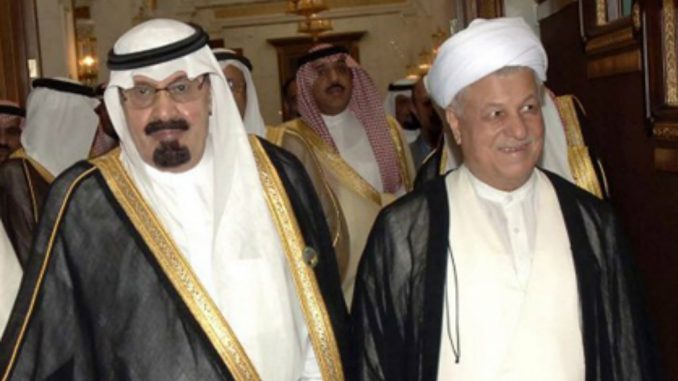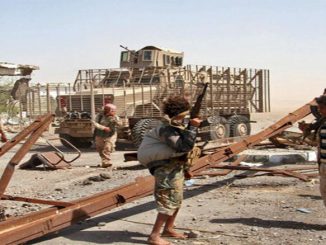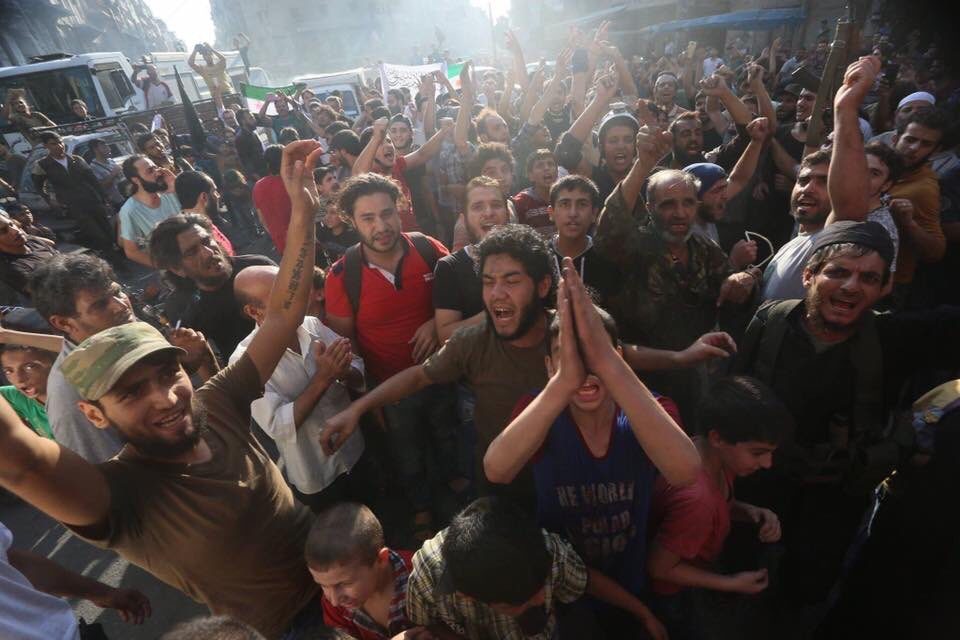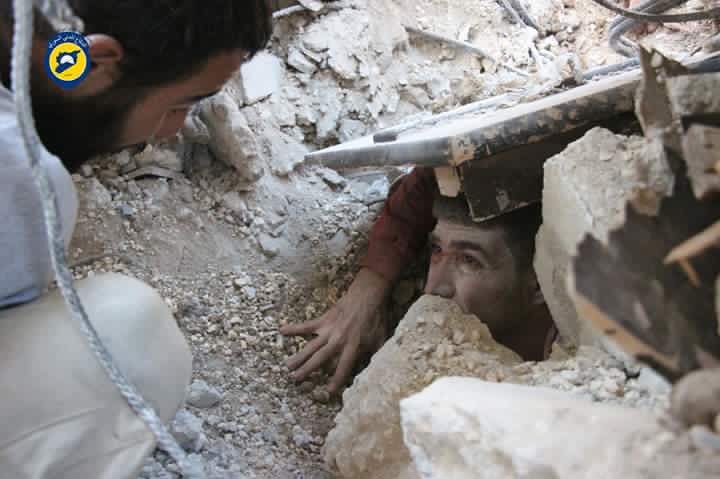
With the death of Hashemi Rafsanjani, many predict that the Saudi-Iranian relations will be far from going back to normal, as he was the man bringing the rivals together in the past.
Rafsanjani, a pragmatist considered Iran’s second most powerful political figure for much of the Islamic Republic’s history, died in hospital in north Tehran on Sunday at the age of 82.
Rafsanjani was a founding member of Iran’s 1979 Islamic revolution that ended the Shah role and brought the clerics’ regime to power. He was a prominent politician after the revolution, and a close person to the former supreme leader Khomeini
When Khomeini died in 1989, Rafsanjani played an instrumental role in the appointment of Ayatollah Ali Khamenei as the current supreme leader.
He served as president for two consecutive terms from 1989 to 1997.
During his leadership, Iran went through an extraordinary transformation as the country focused on post-war construction and industrial revival, as well as trying to revive the relations with the regional rivals, and bridge the divide with them, and ease the tension in the region.
Rafsanjani’s pledge to repair ties with Saudi
Relations between Iran and its neighbors were poisoned since the very first days of the Islamic Revolution in 1979. The successors of what used to be the Iranian monarchy were received with high suspicions from the first days of their reign. Their revolutionary notions were seen as cross-border threats that might cause havoc all over the region. This was one of the reasons the 1980-1988 Iran-Iraq War erupted, and this is why, for years, amity was always an exception that needed exceptional men such as Rafsanjani.
In 1988, then-acting chief of staff of the Iranian armed forces and parliament Speaker Rafsanjani approached the late founder of the Islamic Republic, Ayatollah Ruhollah Khomeini, with what many wouldn’t dare request. Rafsanjani thought it was time for the war with Iraq to come to an end. He gave his reasons and made his point, offering the 88-year-old leader that he could be the scapegoat of such a decision. Khomeini soon afterward made his famous “poison chalice” statement that marked Iran’s compliance with the United Nations Security Council resolution that called for a cease-fire.
“He had been aware of the importance of good relations with neighbors, of unity in an Islamic world where the majority are Sunnis and they [Sunnis] were suspicious of Iran having the aim of exporting its revolution to their nations,” Camelia Entekhabifard, an expert on Arab-Iranian Affairs, said. “Rafsanjani healed the wounds of the post-Iran-Iraq War and melted the hatred between Iranians and their Arab neighbors by making a personal relation with [Saudi] King Abdullah who was then crown prince.”
The personal relationship between the two men helped relaunch Iranian-Saudi and Iranian-Gulf relations positively. Over 1995-1996, Rafsanjani laid the foundation for an era of normalization that flourished under the administration of his successor, Reformist President Mohammad Khatami (1997-2005). Rafsanjani continued to play a main role in maintaining this relation from his position as chairman of the Expediency Council and later as head of the Assembly of Experts.
Former senior Iranian diplomat Hossein Mousavian, who was closely involved with Rafsanjani’s regional outreach in the 1990s, said, “He believed that Iran’s relations with its neighbors should be at the highest level and the most comprehensive ones. He was ready to establish regional security and cooperation based on such an idea.”
Rafsanjani’s most significant visit to Saudi Arabia was that in February 1998, when he stayed for over 10 days, roving around the kingdom.
The uniqueness of Rafsanjani in this regard is a matter that former Saudi diplomat Abdullah al-Shammari also stressed. She said, “It’s true that Rafsanjani’s priority was to serve the interests of his country, yet he was one of the main supporters of good Iranian-Gulf relations in general. He intervened several times to solve crises between Tehran and Riyadh.”
“[Then] President Rafsanjani’s character both as a politician and a family man had its impact on relations between Tehran and other GCC capitals. His June 2008 visit to Saudi Arabia was important. Real efforts were exerted to boost Sunni-Shiite and Iranian-Saudi dialogue.”
Current game of power in the region
Some say that the relations between the two regional rivals worsened after hundreds of people, many of them Iranians, died in a crash at the 2015 Muslim haj pilgrimage in Saudi Arabia, in addition to executing a Shi’ite cleric a year ago by Saudi authorities followed by angry Iranian protesters storming the Saudi embassy in Tehran.
However, the truth is that the rivalry became clear following these incidents, but it was hidden as the Iranian regime kept it despite Rafsanjani’s efforts, and was expressed as a political tension between the two powers which seek to have the bigger influence in the region.
“Recent events in Syria, Iraq, Yemen and Bahrain are among the issues that have created a distance,” the late Rafsanjani said in an interview back in 2015.
The past year witnessed Iran’s victory over Saudi Arabia in many dispute points in the region.
In Yemen, Iran backed the Houthi militias who fought against the Saudi-backed government and overthrown it. The Houthis were able to control large areas of Yemen and Saudi launched a campaign against them but couldn’t neutralize their power. The Houthis then made direct attacks against the Saudi land.
“Yemen will be Saudi Arabia’s Vietnam,” says a contemptuous Iranian official. “It is bleeding the Saudis’ military and diplomatic prestige.” If Saudi Arabia agrees to leave the rest of the region, he says, Iran will let it keep Bahrain, the little island state linked by a causeway to Saudi’s eastern coast.
Iran also firmed its grip on Lebanon, when Saad Hariri, who heads Lebanon’s Sunni bloc and is backed by Saudi Arabia, has accepted the post of prime minister under Hezbollah’s choice for president.
The Hariri-led alliance that struggled with Hezbollah for more than a decade, only to see the heavily armed Shi’ite group go from strength to strength in Lebanon and the wider region.
Iran also supported Assad regime by money and fighters to defend his role agaisnt the Saudi-backed Sunni rebels, in return to freeing Iran’s hand in Syria to achieve its long-awaited dream. Iran started a demographic change in the Sunni-populated areas in Syria and sought to change the face of the Syrian cities by forcing the Shiite festivals in the heart of Damascus, adding Syria to the list of its controlled areas and making it gradually the 32nd Iranian province.
Iran has framed its war effort in sectarian terms, insisting the men it has sent to fight are in Syria to defend the shrine from “Sunni extremists”. In addresses inside Syria, Akram al-Ka’abi, the leader of the Nujaba Front, has exhorted his followers to seek revenge for battlefield losses to Sunni figures in the founding years of Islam.
“The death of Rafsanjani folds an important chapter in the Iranian-GCC [Gulf Cooperation Council] relations. It’s from now on the post-Rafsanjani era,” said Shammari.
“His death indicates that Saudi-Iranian differences will continue in the near future and a chance of serious mediation … is fading,” Shammari said. “What I’m quite sure of is that the future of Saudi-Iranian ties won’t be promising as there’s no conviction that they should be restored or amended.”



